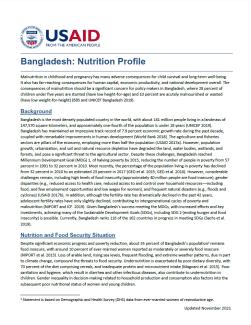Bangladesh is the most densely populated country in the world, with about 161 million people living in a landmass of 147,570 square kilometers, and approximately one-fourth of the population is under 18 years (UNICEF 2019). Bangladesh has maintained an impressive track record of 7.9 percent economic growth rate during the past decade, coupled with remarkable improvements in human development (World Bank 2018). The agriculture and fisheries sectors are pillars of the economy, employing more than half the population (USAID 2017a). However, population growth, urbanization, and soil and natural resource depletion have degraded the land, water bodies, wetlands, and forests, and pose a significant threat to the agricultural sector. Despite these challenges, Bangladesh reached Millennium Development Goal (MDG) 1, of halving poverty by 2015, reducing the number of people in poverty from 57 percent in 1991 to 32 percent in 2010. Most recently, the percentage of the population living in poverty has declined from 32 percent in 2010 to an estimated 23 percent in 2017 (GED et al. 2015; GED et al. 2018). However, considerable challenges remain, including high levels of food insecurity (approximately 40 million people are food insecure), gender disparities (e.g., reduced access to health care, reduced access to and control over household resources—including food, and few employment opportunities and low wages for women), and frequent natural disasters (e.g., floods and cyclones) (USAID 2017b). In addition, although the fertility rate has dramatically declined in the past 42 years, adolescent fertility rates have only slightly declined, contributing to intergenerational cycles of poverty and malnutrition (NIPORT and ICF. 2019). Given Bangladesh’s success meeting the MDGs, with increased efforts and key investments, achieving many of the Sustainable Development Goals (SDGs), including SDG 2 (ending hunger and food insecurity) is possible. Currently, Bangladesh ranks 116 of the 162 countries in progress in meeting SDGs (Sachs et al. 2019).
Document

